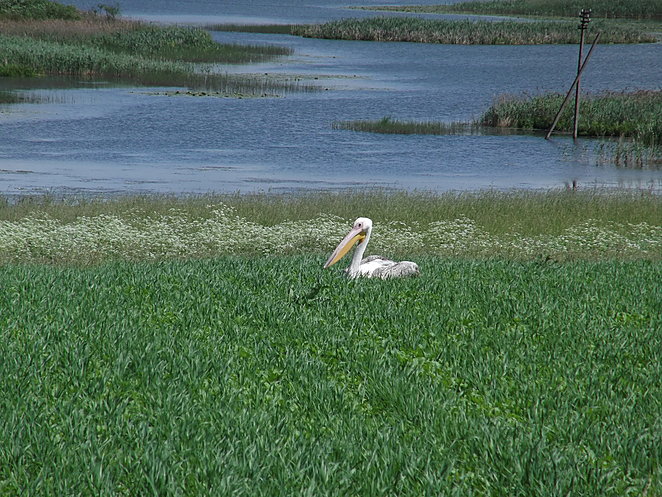| Spring Days, Lithuania. May-June 2014 |

|

|

|
| Written by Jos | |
|
Lesser Spotted Eagles, Ospreys, Red-backed Shrikes, Wrynecks, Corncrakes, the days of spring in Lithuania. Traditionally amongst the most pleasant months in the Baltic States, May and June were marked by migrants, breeders and occasional surprises ...not least an inland Arctic Skua over Labanoras and a White Pelican at Arnionys. Also abundant butterflies, including Poplar Admirals and Purple Emperors.
Labanoras Hotspot.
With birding pretty much excellent at Labanoras non-stop from the tail-end of April through to the middle of June, little did I visit other localities in Lithuania during the period. Not only birds, but abundant other beasties too, including dragonflies (a close up of a Brown Hawker pictured above), a lot of butterflies and assorted amphibians.
Amongst the highlights at Labanoras, the top billings went to a splendid male Black Grouse on 30 April and a totally unexpected Arctic Skua on 7 May, the latter a remarkable record given that my land is over 300 km from the coast! Plenty of other excellent birds too, including the first ever records on my land of Common Sandpiper (three birds on 1 May) and Shoveler (a pair on 3 May), hordes of raptors and a superb array of mugrants and breeding species. Also, as summer crept in, abundant other beasties too, including dragonflies (a close up of a Brown Hawker pictured below), a lot of butterflies and assorted amphibians.
Migrants and breeders.
The merry month of May, oodles of birds arriving back on territory at Labanoras - to a backdrop of Thrush Nightingales, Icterine Warblers and Marsh Warblers, treats for the ears and eyes abounded.
Red-backed Shrikes adorning specially-created 'shrike piles', Golden Orioles flashing yellow and black in the forest, Corncrakes rasping in the meadows, East Europe at its best. Ten-a-penny Whinchats and Pied Flycatchers, White Storks abundant, Black Terns hawking over, White-winged Black Terns on one occasion, birds at every turn. White-backed and Middle-spotted Goldeneyes with seven little ducklings, Teal and Mallard following suit a little later, Green Sandpipers breeding in the flood forest, a good season for water birds too, the slow transition from forest to wetland continuing with 2014 seeing my best ever totals of Sedge Warblers breeding (only colonised in 2009, six to seven singing birds now), Common Cranes seemingly occupying a reedy clearing and a Reed Bunting on territory. In damp grass nearby, Lapwings Pride of place amongst the breeders however, were the Wrynecks - though two to three pairs breed annually, most privileged indeed to I feel to share my land with these exquisite birds. Two pairs in 2014, both in nestboxes, one in the depths of the forest, but the second in a solo tree a few hundred metres from the woodland edge ...splendid views the birds give as they to and fro from the box.
Raptor Lux.
To recline on a deckchair atop my 'raptor viewpoint' on a sunny day in May or June, a glorious experience it is. Plenty to watch for, rarely the skies devoid of a Common Buzzard or Marsh Harrier, frequently something a little more juicy too. Heading the list and probably breeding in the immediate area, Ospreys, Black Kites and Hobbies all appeared with fair frequency, while Lesser Spotted Eagles were notable by the infrequency, just a couple of records all season. Also managed two Kestrels on 3 May, an adult White-tailed Eagle on 11 May, no less than four Montagu's Harriers in mid-May and a Honey Buzzard on 14 June. Sparrowhawks also seen ...all in all, raptor lux indeed!
Non-birds.
Mammalian bounties at Labanoras, a good variety of beasties seen during the period - a big female Elk munching grass atop of fallen tree-stump, Wild Boars on several occasions, a Brown Hare on one, a Pine Marten on another, plus regular Roe Deer and Red Fox.
However, for all the mammals,with the progression of spring, so the season tilts towards butterflies, the numbers and variety slowly increasing - at favoured localities in Rudninkai Forest and in the Neris Valley, a pretty good collection on show, topped by a couple of stunning Poplar Admirals, localised Queen of Spain Fritillaries and the exquisite Woodland Brown.
Amongst the species seen:
Pelican Oddity
White Pelican visits Lithuania! With only about 25 records ever in the country, this is a sight indeed ...especially with Corncrake calling as a backdrop and clouds of White-winged Black Terns either side!
This is not my picture! Instead, it is the image that stared out of the page on the website of Lithuania's leading national newspaper, the Lietuvos Rytas!
(picture: A.Noreikaite, Lietuvos Rytas)
Well, faced with that, I really had to make the effort to read the paper! It turned out that the bird had been spotted barely a dozen kilometres as the pelican flies from my Labanoras land, the guy spending the weekend at his summer house overlooking Pravalas Lake. Hmm, wellI did fancy a stab at that, so a couple of days later, a little detour on my way to my land, a few meanders around trying to access the lake and there he was, sat out on a little island preening and not caring a jot for anything!
|
|
| Last Updated ( Saturday, 21 June 2014 ) |
| < Prev | Next > |
|---|





 Woodpeckers fledged their young and a right bevy of Starlings fledged from a bunch of extra nestboxes I erected.
Woodpeckers fledged their young and a right bevy of Starlings fledged from a bunch of extra nestboxes I erected.  poked about with two chicks.
poked about with two chicks. 





